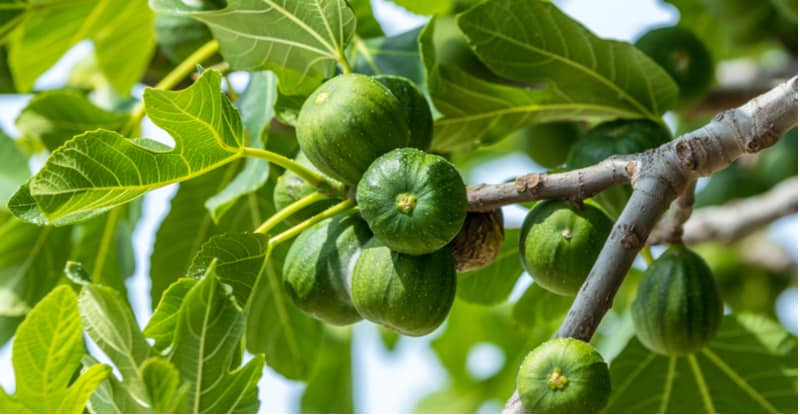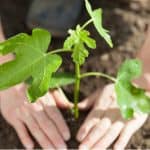Last updated on March 14th, 2022
Our site is reader supported, this means we may earn a small commission from Amazon and other affiliates when you buy through links on our site.
Growing fig trees in containers is a wonderful way to grow smaller varieties of fruit trees in your home, perhaps in an apartment or outside on a patio for those of you who don’t have large gardens. It’s also a great way to control the size of varieties that might otherwise grow too large. Growing in containers requires the same general care and maintenance as growing anything else.
One of the benefits of growing in containers is that you can leave your fig tree outside for the majority of the year, giving it ample exposure to light and water, and then move it indoors for the winter. This is a great way to protect the small tiny fruits that will be the fruit you harvest the following year.
Fig trees are from the Mediterranean originally, so they do best with mild climates and do not thrive in extreme cold, although there are some excellent varieties (such as ‘Brown Turkey’) that grow very well in the UK. By growing in containers you can either keep them inside in a cold greenhouse so it doesn’t get exposed to the harsh cold winters or you can leave them outside and then move them indoors during the winter where you can bring them back outdoors in spring.
Every four years, in the winter, you should repot your fig tree. When you do this you can also remove approximately 25% of the root system to keep it to the size you desire. This should only be done when the plant is dormant, with the best time being autumn or early spring before new growth begins.
Choosing a Pot
First and foremost you need to be mindful of the variety you choose. This is twofold. Firstly, you need to pick up a variety that won’t outgrow the space you have available, this is usually not a huge issue because the size is controlled by the restricted pot size. However, if you choose a particularly large variety you might need an oversized container to grow it, and oversized containers once full of potting soil and young trees become incredibly heavy.
You need to make sure you have a space lined up for the container and the tree that has enough space for the root system to grow and enough space above the planter for the branches to grow.
Ideally, a pot that is around 2ft by 2ft is perfect. Secondly, if you plan on enjoying the fruits on your fig tree you will need to pick a self-pollinating variety so that you don’t have to plant multiple fig trees in one area. You can plant one self-pollinating variety per container and in the spring add fertiliser, such as tomato feed, to encourage the growth and production of fruit.
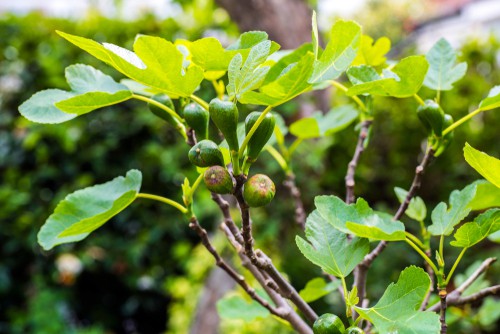
Planting Fig Trees in Pots
Compost and Feed
When growing indoors, use regular potting soil (such as John Innes No 3) mixed with some grit to improve the drainage, and as previously mentioned, feeding them during the spring with a high-potassium feed, such as tomato feed, will do very well for all varieties. As mentioned above, when you grow your figs in containers it’s important that you move the container beforehand to the location you want to keep it permanently and then fill it with soil, water it thoroughly so that all of the potting compost is moist and then plant your fig tree. You don’t want to plant it outside and then have to pick up a very heavy planter if you don’t have to.
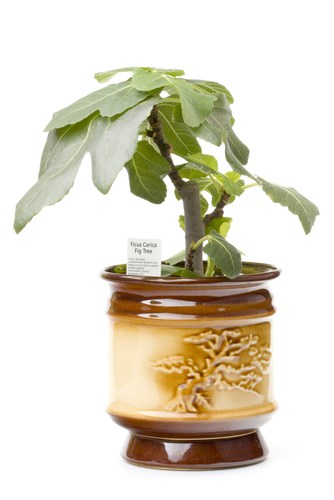
Watering
You should water regularly as and when required. You can always test the soil for dampness the same as you would test any other planter. If it begins to dry out, or you see the leaves start to wilt it’s time to add more water. Don’t overwater them because this can lead to root rot, which is a common mistake many people make. Fig trees need a lot of light (the same as any other tree) and this can be in direct sunlight, so placing it near a window or in a brightly lit room is best if you choose to grow them indoors. If outdoors, positioning them in a nice sheltered spot with plenty of sun will be best.
Fig trees need to be fed and watered at very regular intervals when they are grown in containers. You should them feed at least every two weeks during their main growth period, all the way until the end of August, and watered as needed. Remember this is a rough guide so during times of hot weather watering every day could be necessary, but be careful not to overwater them.
Pruning Fig Trees in Pots
If you need to prune your fig trees, you can do so in early spring. The fruits will typically ripen in the middle of summer, after which you can either trim your tree gently or give it a heavy pruning depending on what it needs. Heavy pruning is best done in February. Younger trees respond much better to regular, light pruning because this helps to encourage stronger main branches. The fruit is grown on branches from the season prior so if you cut these terminal branches, you won’t get any fruit the following season.
When you set out to prune your fig trees make sure that the pruning secateurs you use have been properly sanitised so that you don’t accidentally transfer any diseases. With younger trees, you should remove any suckers that are branching out from the base of the main structure. You also want to trim any excess branches, the idea is to choose 4-6 main branches as the fruiting wood and then remove any other branches.
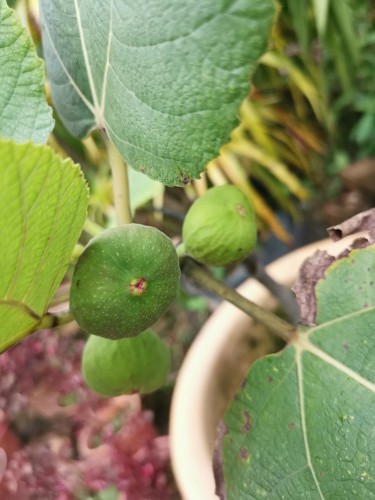
Once your fig tree has reached maturity, you won’t need to prune it quite as much. You’ll just need to remove any crossing stems, dead or diseased stems.
You can read a more in-depth guide on pruning fig trees here.

